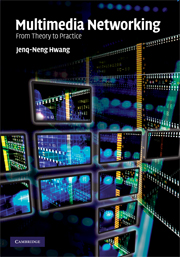Book contents
- Frontmatter
- Contents
- Preface
- Acknowledgements
- List of abbreviations
- 1 Introduction to multimedia networking
- 2 Digital speech coding
- 3 Digital audio coding
- 4 Digital image coding
- 5 Digital video coding
- 6 Digital multimedia broadcasting
- 7 Multimedia quality of service of IP networks
- 8 Quality of service issues in streaming architectures
- 9 Wireless broadband and quality of service
- 10 Multimedia over wireless broadband
- 11 Digital rights management of multimedia
- 12 Implementations of multimedia networking
- Index
10 - Multimedia over wireless broadband
Published online by Cambridge University Press: 26 January 2010
- Frontmatter
- Contents
- Preface
- Acknowledgements
- List of abbreviations
- 1 Introduction to multimedia networking
- 2 Digital speech coding
- 3 Digital audio coding
- 4 Digital image coding
- 5 Digital video coding
- 6 Digital multimedia broadcasting
- 7 Multimedia quality of service of IP networks
- 8 Quality of service issues in streaming architectures
- 9 Wireless broadband and quality of service
- 10 Multimedia over wireless broadband
- 11 Digital rights management of multimedia
- 12 Implementations of multimedia networking
- Index
Summary
The rapid growth of wireless broadband networking infrastructures, such as 3G and 3.5G, WLAN and WLAN-mesh, and WiMAX, makes available multimedia (audio and video) information and entertainment (“infotainment”) in our lives anytime, anywhere, on any device. However, wireless multimedia delivery faces several challenges, such as a high error rate, bandwidth variation and limitation, battery power limitation, and so on. Take, for example, the voice over IP (VoIP) and video streaming applications, which are quite mature in wireline infrastructure. At the same time, wireless broadband based on WLAN and WiMAX is also becoming widespread. While these wireless networks were not designed with real-time multimedia communication services in mind, their widespread availability and low cost makes them an inviting solution for adding mobility to these communication services. The major issue is how to achieve a wireless broadband system which can deliver real-time interactive multimedia smoothly and still satisfy the QoS metrics typically used to define the quality of a VoIP or video conferencing session, e.g., the one-way delay, jitter, packet loss rate, and throughput (see Section 7.2).
Advances in media coding over wireless networks are governed by two dominant rules [1]. One is the well-known Moore's law, which states that computing power doubles every 18 months. Moore's law certainly applies to media codec evolution, and there have been huge advances in technology in the ten years since the adoption of MPEG-2. The second governing principle is the huge bandwidth gap (one or two orders of magnitude) between wireless and wired networks. This bandwidth gap demands that coding technologies must achieve efficient compact representation of media data over wireless networks.
- Type
- Chapter
- Information
- Multimedia NetworkingFrom Theory to Practice, pp. 365 - 409Publisher: Cambridge University PressPrint publication year: 2009

